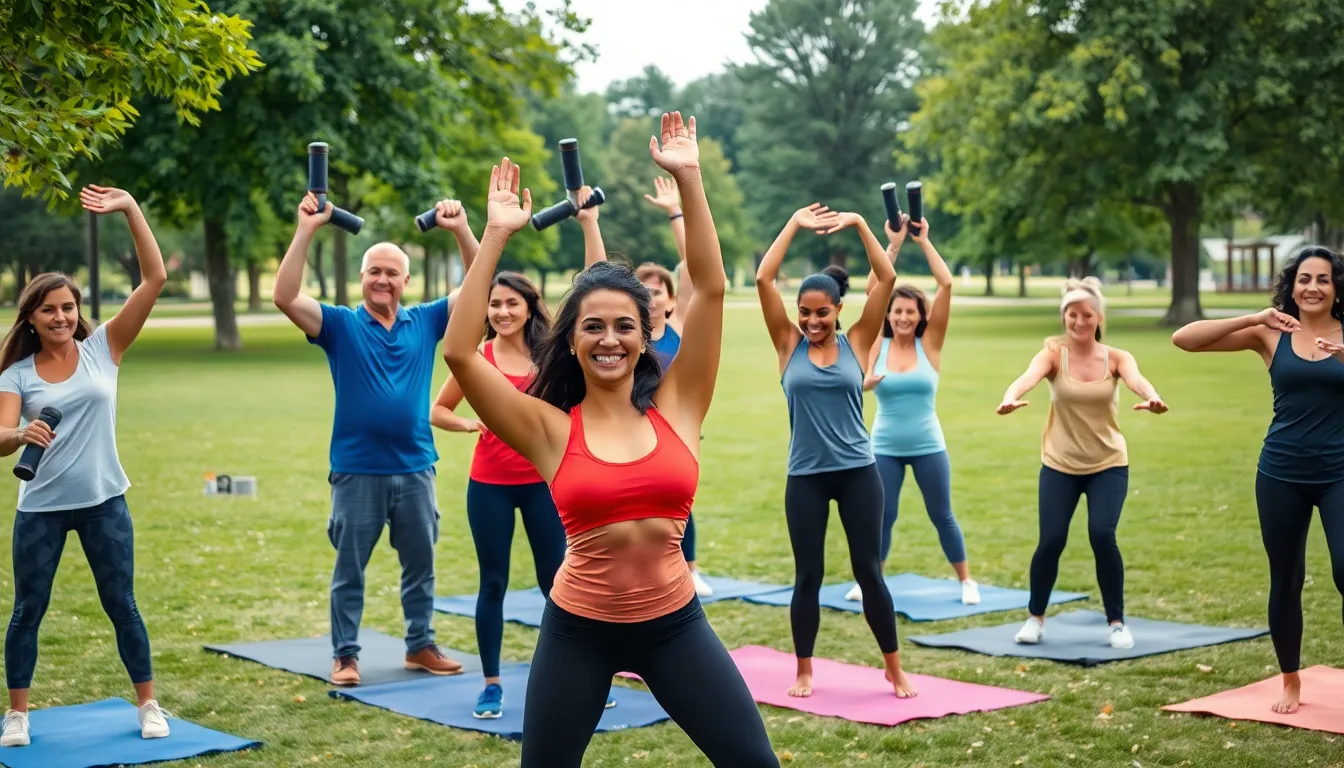In today’s fast-paced world, the fitness community has emerged as a vital support system for individuals striving to achieve their health goals. It’s more than just a group of people working out together; it’s a network of motivation, encouragement, and shared experiences. From local gyms to online platforms, these communities foster connections that inspire members to push their limits and celebrate their progress.
Engaging with a fitness community can transform one’s approach to health and wellness. It offers accountability and camaraderie, making workouts more enjoyable and effective. Whether through group classes, social media interactions, or fitness challenges, the sense of belonging can elevate one’s commitment to a healthier lifestyle. In this article, we’ll explore the benefits of being part of a fitness community and how it can lead to lasting change.
Table of Contents
ToggleWhat Is a Fitness Community?
A fitness community refers to a group of individuals who come together to support and motivate each other in their health and wellness journeys. Fitness communities exist in various forms, including local gyms, classes, sports teams, and online platforms.
Key Characteristics of a Fitness Community
- Support Networks: Members provide encouragement to one another, fostering a supportive atmosphere that enhances the overall experience.
- Shared Goals: Participants often have similar fitness objectives, which creates a sense of camaraderie and helps maintain focus on achieving these goals.
- Accountability: Regular interaction among members helps hold each other accountable, increasing commitment to workouts and healthy practices.
- Resource Sharing: Communities often exchange valuable information, including workout tips, nutrition advice, and personal experiences, contributing to collective knowledge.
Types of Fitness Communities
- Local Gyms: Many individuals engage in fitness at local gyms, where group classes and social events help form connections.
- Online Platforms: Virtual fitness groups facilitate communication and support through forums, social media, and dedicated apps.
- Sports Teams: Joining a sports team not only promotes physical activity but also builds strong relationships among teammates.
Fitness communities play a crucial role in promoting a healthier lifestyle by connecting individuals, fostering motivation, and increasing enjoyment in physical activities.
Benefits of Joining a Fitness Community

Fitness communities offer numerous advantages that enhance individuals’ health journeys. Members experience increased motivation, accountability, and access to valuable resources and knowledge.
Motivation and Accountability
Motivation thrives in a fitness community. Participants gain encouragement through shared experiences, fostering an environment where individual goals become collective achievements. Regular group workouts inspire members to push harder, as seen in studies indicating that exercising with others can boost performance by up to 30%. Accountability arises as individuals commit to their fitness goals, knowing peers monitor their progress, making it less likely to skip workouts or abandon routines. Overall, the strengthened social ties encourage ongoing commitment to healthier lifestyles.
Access to Resources and Knowledge
Access to resources and knowledge enhances the effectiveness of workouts. Fitness communities often provide expert advice through trainers, nutritionists, or seasoned members who share insights. This exchange of information can lead to better exercise techniques and nutritional strategies, resulting in improved performance and health outcomes. Additionally, members may benefit from workshops, webinars, and fitness challenges that introduce new practices and ideas. The collaborative learning environment fosters growth and can motivate individuals to explore diverse fitness options they may not pursue alone.
Types of Fitness Communities
Fitness communities vary significantly, offering unique experiences and interactions that cater to diverse preferences and goals. These communities can be broadly categorized into online fitness communities and local fitness groups.
Online Fitness Communities
Online fitness communities provide a platform for individuals to connect virtually, often through social media, forums, and specialized apps. Members share experiences, tips, and support regardless of geographic location. These communities can include:
- Social Media Groups: Platforms like Facebook and Instagram feature groups focused on specific fitness goals, such as weight loss or strength training.
- Fitness Apps: Applications like MyFitnessPal and Strava allow users to track workouts, share achievements, and participate in challenges with other members.
- Virtual Classes: Online classes on platforms like Zoom and YouTube connect users with trainers and fellow fitness enthusiasts, fostering a sense of belonging.
Online fitness communities offer flexibility, allowing members to engage at their own pace and convenience, making fitness accessible to a wider audience.
Local Fitness Groups
Local fitness groups consist of individuals who meet in person to exercise together. These groups can take various forms, including:
- Gym Classes: Many gyms host group fitness classes such as yoga, cycling, and CrossFit, enabling participants to work out in a structured environment.
- Running Clubs: Local running or walking groups provide opportunities for members to train for events while fostering camaraderie and support.
- Sports Teams: Amateur sports teams create a sense of community while promoting fitness through organized activities and matches.
Local fitness groups encourage social interaction, enhance motivation, and provide a direct support system, contributing to improved fitness outcomes for participants.
How to Find the Right Fitness Community
Finding the right fitness community involves understanding personal goals and values. Individuals can significantly enhance their health journey by aligning their needs with community characteristics.
Assessing Your Goals and Interests
Identify specific fitness goals to guide the search for a suitable community. Individuals may aim for weight loss, muscle gain, or improved endurance. Recognize personal interests, like group classes, outdoor activities, or competitive sports, which shape the ideal community. Analyze preferences for workout styles—high-intensity training, yoga, or team sports—to enhance engagement and commitment. Assessing these factors leads to a more fulfilling experience within a fitness community.
Evaluating Community Values and Culture
Consider the values and culture of potential fitness communities. Individuals should seek groups that emphasize encouragement, inclusivity, and support. Research the community dynamics, such as the level of motivation expressed by members and leadership styles of instructors. Attend trial classes or community events to gauge the atmosphere and interactions. Strong alignment between personal values and community culture fosters a sense of belonging and promotes sustained participation in fitness endeavors.
Embracing a fitness community can transform one’s health journey into a fulfilling experience. These supportive networks not only provide motivation but also foster lasting friendships and shared achievements. By connecting with like-minded individuals, members can enhance their commitment to fitness while enjoying the process.
Whether through local gyms or online platforms, the sense of belonging found in these communities is invaluable. They create an environment where accountability thrives and personal goals become more attainable. Joining a fitness community is more than just a workout; it’s a step towards a healthier and happier lifestyle.









